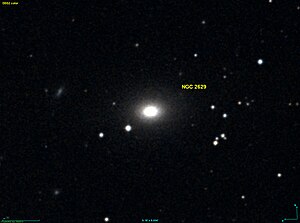NGC 2629
| Galaxy NGC 2629 |
|
|---|---|

|
|
| AladinLite | |
| Constellation | Big Bear |
|
Position equinox : J2000.0 , epoch : J2000.0 |
|
| Right ascension | 08 h 47 m 15.8 s |
| declination | + 72 ° 59 ′ 08 ″ |
| Appearance | |
| Morphological type | SA (r) 0 ^ 0 ^: |
| Brightness (visual) | 12.3 mag |
| Brightness (B-band) | 13.3 mag |
| Angular expansion | 1.5 ′ × 1.3 ′ |
| Position angle | 105 ° |
| Surface brightness | 13.1 mag / arcmin² |
| Physical data | |
| Affiliation | IC 520 group LGG 162 |
| Redshift | 0.012459 ± 0.000080 |
| Radial velocity | 3735 ± 24 km / s |
|
Stroke distance v rad / H 0 |
(172 ± 12) · 10 6 ly (52.8 ± 3.7) Mpc |
| history | |
| discovery | William Herschel |
| Discovery date | September 30, 1802 |
| Catalog names | |
| NGC 2629 • UGC 4569 • PGC 24682 • CGCG 331-062 • 332-009 • MCG + 12-09-010 • 2MASX J08471585 + 7259082 • GC 1679 • H III 982 • NVSS J084715 + 725909 • LDCE 573 NED016 | |
NGC 2629 is an elliptical galaxy of Hubble type E / S0 in the constellation Ursa Major at the northern sky . It is estimated to be 172 million light years from the Milky Way and about 75,000 light years across.
Together with NGC 2614 , NGC 2646 , IC 520 it forms the IC 520 group .
The object was discovered by Wilhelm Herschel on September 30, 1802 .
